What a big year for changes in the US helicopter industry – first the switch from PTS to ACS for helicopter pilot certification and now changes to SFAR 73 (effective August 22nd, 2024).
SFAR 73 Changed Video
Don’t like to read? Watch a video covering the SFAR 73 changes:
What is SFAR 73?
Special Federal Aviation Regulation, No. 73 (or SFAR 73 for short) is a set of rules that apply to anyone who wants to manipulate the flight controls, act as Pilot In Command (PIC), carry passengers, or teach in Robinson R22 and R44 helicopters (it does not apply to the R66). It details required training and experience for those that want to fly and/or teach in R22 and R44 helicopters on top of the usual regulations for helicopter pilots in the USA.
Learn more details of the full SFAR 73 in HTV’s article SFAR 73 Explained.
History
1979
FAA issued the R22 type certificate
1992
FAA issued the R44 type certificate
1995
According of the FAA’s R22 accident analysis (with recommendations from the NTSB):
“…had a high number of fatal accidents…compared to other piston powered helicopters.”
“…attributed to pilot performance or inexperience, where low RPM or low G conditions caused mast bumping or main rotor-airframe contact accidents”
“Certain aerodynamic and design features…result in specific flight characteristics that require particular pilot knowledge and responsiveness to operate these models safely.”
The R44 had just recently been certified and the FAA thought it’s design was close enough to the R22 to warrant the same concerns. And so SFAR 73 was created.
“FAA determined specific training and experience requirements were necessary for the safe operation of… [the R22 & R44]”
Three months later, (due to an R44 accident in Germany) Airworthiness Directives AD 95-11-09 & AD 95-11-10 issued which prohibit intentional low gravity (low-G) flight in the R22 & R44, contrary to the SFAR 73 Low-G flight training requirement.
Why SFAR 73 came to be is best described by Tim Tucker (of Robinson Helicopters) in his own words – The Story Behind Special FAR 73.
2011
The FAA formed a Safety Risk Management (SRM) Team to assess SFAR 73. The Team was comprised of representatives from various FAA divisions as well as Helicopter Association International (HAI), Robinson Helicopter Company, & 2 Designated Pilot Examiners (DPEs). They came up with a 49 page report with various recommended changes. It is interesting reading, especially the statistics and the comments/recommendations put forward by each entity.
The report looked at NTSB accident data for the R22, R44 and R66 from 1980 to 2021, breaking down accidents by type relevant to SFAR 73 both before and after the SFAR 73 regulation was published.
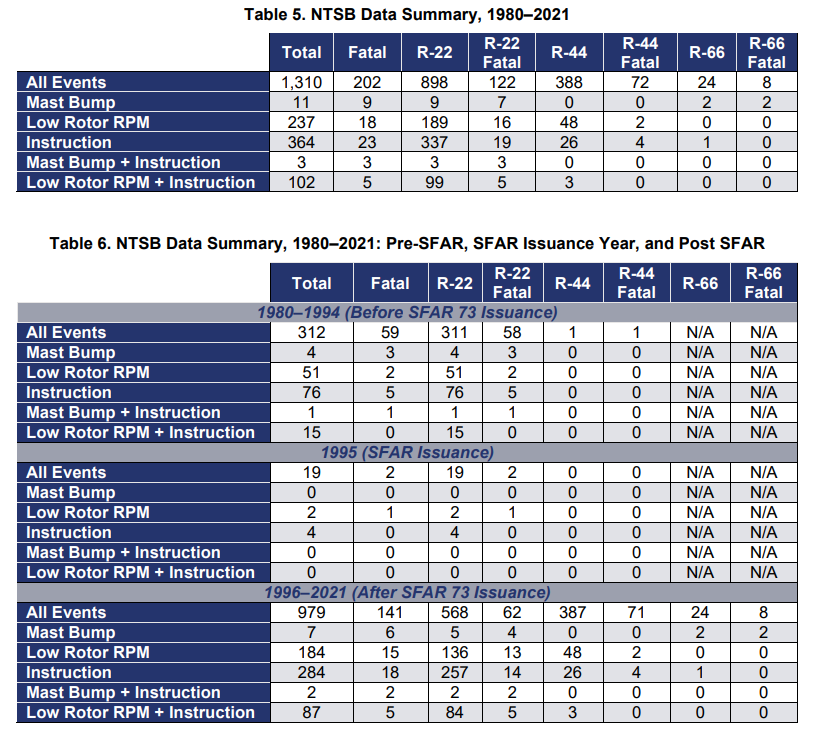
2023
October 2023 the FAA published a Notice of Proposed Rulemaking (NPRM) for the proposed changes to SFAR 73 and opened the changes to public comment. Only 5 comments were received (by Robinson, HAI and three individuals). One of the comments (from Robinson) was to request the R44 be removed from SAFR 73 but that was denied at this point. The FAA will be considering that suggestion and other recommendations from the SRM Report in the next five years.
2024
The new version of SFAR 73 was published July 23rd 2024 and becomes effective August 22nd, 2024.
The Changes
‘Enhanced’ Autorotation Training Clarification
Under the old SFAR 73, the flight training required “Enhanced training in autorotation procedures” but enhanced is never defined by the FAA. According to the FAA Noticed of Proposed Rulemaking:
…the FAA intends “enhanced” to mean different autorotation iterations. However, the term lacks sufficient specificity to adequately inform the regulated community what autorotation maneuvers are expected to be performed.
So the FAA removed “enhanced” and specified what sort of autorotation training they wanted in two parts:
(A) Training in autorotation procedures and energy management, including utilizing a combination of flight control inputs and maneuvering to prevent overshooting or undershooting the selected landing area from an entry altitude that permits safe recovery;
Part A pulled in energy management to the flight training and then goes on to detail the autorotations should utilize a combination of control inputs and maneuvering to prevent over/undershooting the spot. How else could you maneuver without use of the flight controls? Leaning heavily? Also, seems unnecessary to have to tell a pilot to select a safe altitude to do this training…
The second part become more specific about the autorotation configuration(s) to use, making a distinction between R22 and R44. SFAR 73 now requires minimum rate of descent autorotation training in the R44 but not the R22 because the R44 has a minimum rate of descent autorotation configuration published in the R44 POH and the R22 does not.
The final SFAR 73 wording for the R44 regarding autorotaions becomes:
(B) Autorotations at an entry altitude that permits safe maneuvering and recovery utilizing minimum rate of descent configuration and maximum glide configuration;
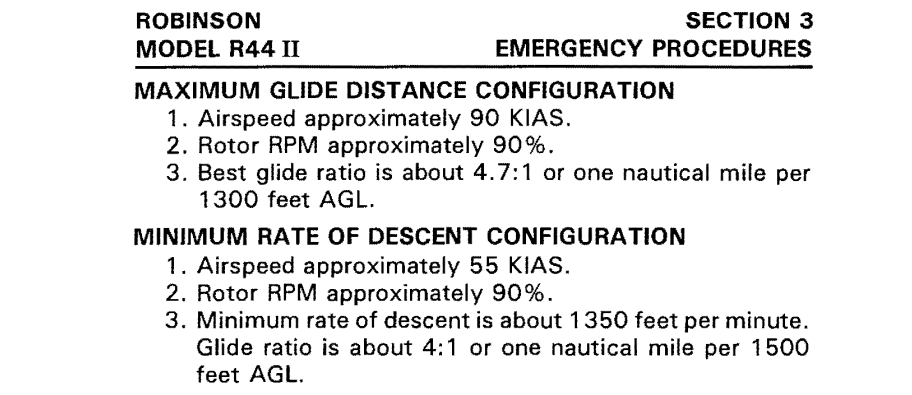
And for the R22 it is identical except the absence of minimum rate of descent:
(B) Autorotations at an entry altitude that permits safe maneuvering and recovery utilizing maximum glide configuration;

I think most instructors have been teaching minimum rate of descent in the R22 anyway, using 90% RPM and 53 KIAS (based on the R22 POH best rate of climb speed). And they will probably continue to teach minimum rate autorotations in the R22, regardless of the SFAR 73 change.
Removed Low-G Flight Training
Almost immediately after SFAR 73 was published an R44 Low-G accident in Germany resulted in two Airworthiness Directives (AD 95-11-09 & AD 95-11-10) which prohibited intentional low gravity (Low-G) flight in the R22 & R44, contrary to the SFAR 73 Low-G flight training requirement. And for nearly 30 years the contradiction remained. I personally took that to mean while we can not get into Low-G, we can train on Low-G recovery in flight and I think that is very valuable flight training – working on muscle memory for recovery. Unfortunately the FAA did not see it that way, and instead of just rewording the SFAR to say “flight training on Low-G recovery from a theoretical Low-G scenario“, they took it out of the flight training requirement completely. I will continue to train on recovery, see below:
Goodbye GELL, Hello GIML!
In the past instructors and students have used GELL as a memory aid for the SFAR 73 flight training requirements (Governor off, Enhanced autos, Low RPM & Low G).
With the new SFAR 73 changes that won’t work, so I am suggesting GIML or GIM²L for the R44:
G = Governor Off RPM control
I = Inputs to avoid over/undershoot in an autorotation
M = Max glide [& Min rate in R44] autorotation
L = Low RPM recognition & recovery
Let me know if you have a better idea in the comments below.
Renamed “Awareness Training”
To be consistent with terms and definitions used for training in the other parts of the FARs, “Awareness Training” will be renamed “Ground Training“. Part 61 defines “Ground Training“ as:
“…training, other than flight training, received from an authorized instructor.”
This will probably require a slight wording change to endorsement issued, but will not affect old endorsements given under the “Awareness Training” name.

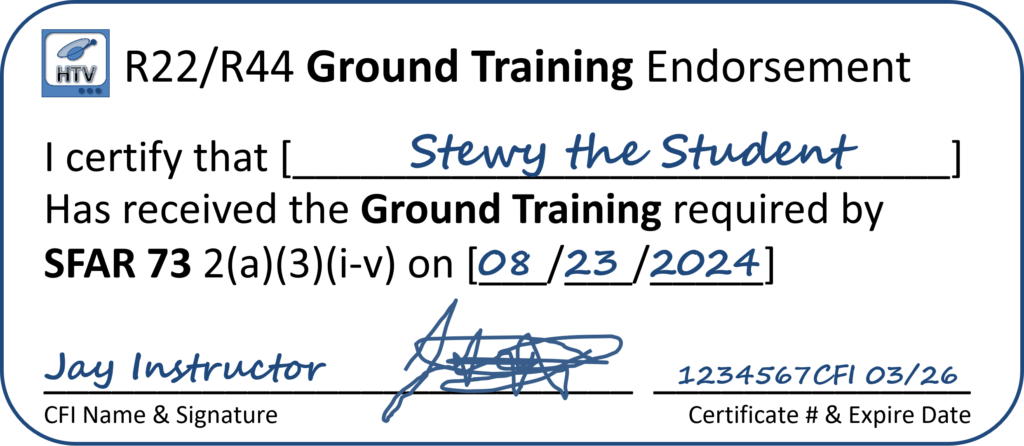
Renamed “Blade Stall”
The term “Blade Stall” can be confused with Retreating Blade Stall which is a completely different thing. Low RPM leads to “Rotor Stall” and so that is the term used going forward. I think most instructors used that term anyway, knowing the “blade stall” terms in inaccurate. “This “Rotor Stall” is also consistent with Robinson Safety Notices and the Helicopter Flying Handbook:
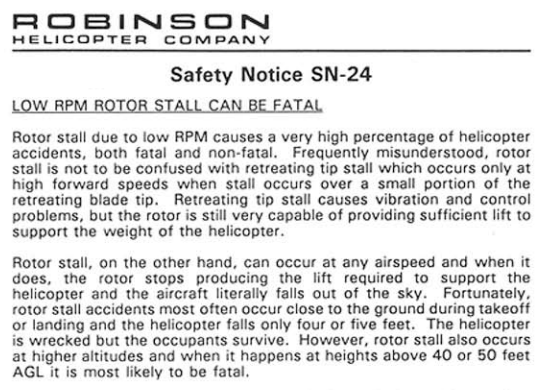
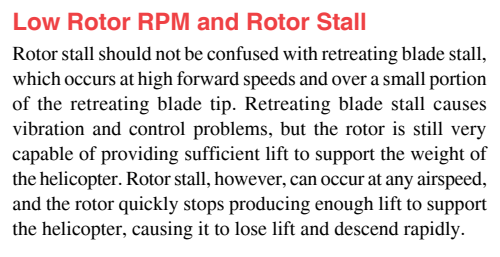
Renamed “Certified Instructor”
Similar to the change from “Awareness Training” to “Ground Training“, the new SFAR 73 replaces “Certified Instructor” with “Instructor authorized under SFAR 73…“. The FAA uses the term “Authorized Instructor” throughout regulations.
Old SFAR 73
Awareness training must be conducted by a certified flight instructor who has been endorsed under paragraph (b)(5) of this section
New SFAR 73
Ground training must be conducted by a flight instructor who has been authorized under paragraph 2(b)(5)(iv) of this SFAR
Later in SFAR 73 the requirements to become an “authorized instructor” are defined (they have not changed) and include:
“Has been authorized by endorsement from an FAA aviation safety inspector or authorized designated pilot examiner…”
Reformatted 12 Month Review
For pilots with less than 200 hours helicopter and less than 50 hours in the R22 or R44 there is an annual flight review requirement under SFAR 73. The annual review details were hard to discern as they were in general PIC requirements paragraph:
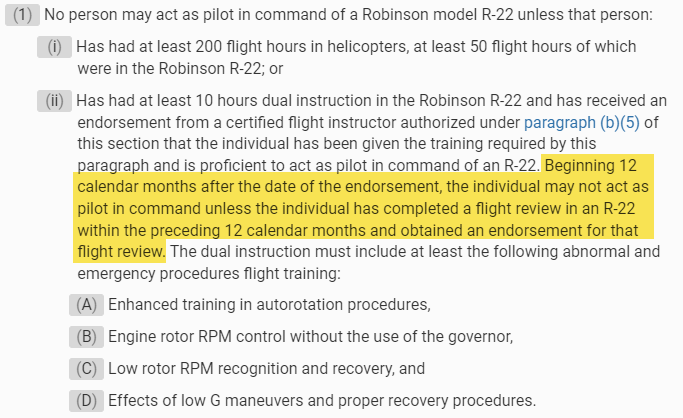
Now the annual review details has it’s own dedicated paragraph with added references to required ground and flight training to fulfil that review. Although the formatting is not yet the same as the published version, you can see below how it will have it’s own clearly defined paragraph and will make finding and reading much easier:
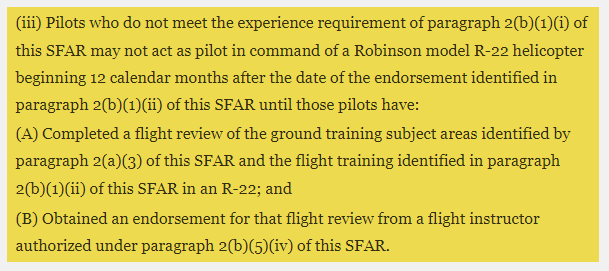
Removed Legacy Dates
These dates made sense when SFAR was introduced nearly 30 years ago, but now they are unnecessary and have been removed:
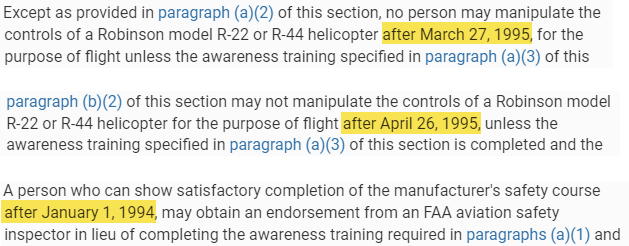
Added 5 Year Expiration
The old version of SFAR 73 had an expiration date of:
“This SFAR No. 73 shall remain in effect until it is revised or rescinded.”
But the FAA is not finished with changes to SFAR 73, so they have added a 5 year expiration date to the new SFAR 73:
” This SFAR expires August 22, 2029, unless sooner revised or rescinded.”
Future
There were many recommendations in the SRM Report not adopted in this SFAR 73 update – as the FAA stated in the Final Rule:
“This rulemaking was not intended to implement all recommendations set forth by the SRM Team.”
The FAA also stated in that:
“…FAA undertook this rulemaking to adopt recommendations that would not substantively change the current training and experience regime as the first step in a tiered, long-term revision to the SFAR”.
Over the next 5 years FAA plans to:
“…FAA proposed to add an expiration date to the SFAR to allow the FAA time to review and refine the requirements for R-22 and R-44 helicopters for eventual movement into a permanent location in title 14…”
I already have so many questions about the next update like will the R44 be removed from SFAR 73 and will the new horizontal stabilizer design change things? I guess we will find out in 2029 – and I imagine many of you will not be flying R22s and R44s by then!!
In the meantime I better start updating all the SFAR 73 articles and videos I made, including this one:
More Info
For more information on SFAR 73 check out the following:
- SFAR 73 Changes 2024 video
- SFAR 73 Explained article
- SFAR 73 Awareness Training video and quiz
- Logging PIC in R22 & R44 article
- Robinson Helicopters SFAR 73 Website
- R22 POH or R44 POH
- The Story Behind Special FAR 73 by Tim Tucker (of Robinson Helicopters)
- SFAR 73 Final Rule 89 FR 59602
- FAA SFAR 73 SRM Report
- AD 95-11-09 & AD 95-11-10
- Mitsubishi MU-2B SFAR 108 & Part 61 Subpart N
If you want to purchase the latest paper version of the FAR AIM these Amazon affiliate links help support HTV at no extra cost to you. And as always, the very latest regulations are always viewable online at www.efc.gov.
DISCLAIMER – make sure you are fully informed on the latest regulations and their application.
For official guidance on laws and regulations, refer to your Certified Flight Instructor (CFI) or local Flight Standards District Office (FSDO) . Helicopter Training Videos aims to promote aviation knowledge and safety but makes no guarantees regarding accuracy or legal applications.
Feedback
What do you think of the changes to SFAR 73? What about using GIML? Or something else? Let us know using the comments form below:



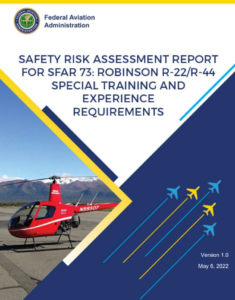


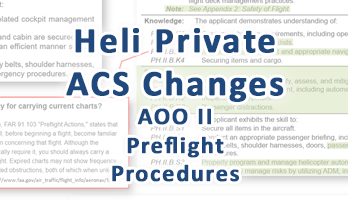
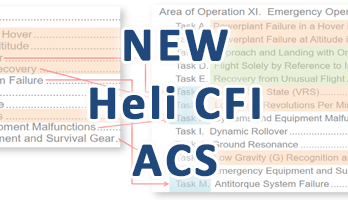
Great Information thanks!
Does this make older SFAR 73 R44 Endorsements Obsolete? I need to get my R44 PIC Endorsement training completed, so should I wait till after August 22nd?
Great question – the FAA Final Rule states that all endorsements prior to Aug 22nd 2024 are still valid. So no worries and no need to delay training/endorsement.
Thanks Jay for pulling all this together!
Thank you for all you do too Mick!